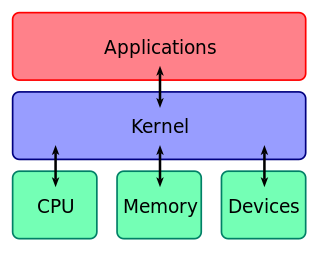Related Research Articles
Communications of the ACM is the monthly journal of the Association for Computing Machinery (ACM). It was established in 1958, with Saul Rosen as its first managing editor. It is sent to all ACM members. Articles are intended for readers with backgrounds in all areas of computer science and information systems. The focus is on the practical implications of advances in information technology and associated management issues; ACM also publishes a variety of more theoretical journals. The magazine straddles the boundary of a science magazine, trade magazine, and a scientific journal. While the content is subject to peer review, the articles published are often summaries of research that may also be published elsewhere. Material published must be accessible and relevant to a broad readership.
A heuristic evaluation is a usability inspection method for computer software that helps to identify usability problems in the user interface design. It specifically involves evaluators examining the interface and judging its compliance with recognized usability principles. These evaluation methods are now widely taught and practiced in the new media sector, where user interfaces are often designed in a short space of time on a budget that may restrict the amount of money available to provide for other types of interface testing.
The Andrew Project was a distributed computing environment developed at Carnegie Mellon University beginning in 1982. It was an ambitious project for its time and resulted in an unprecedentedly vast and accessible university computing infrastructure. The project was named after Andrew Carnegie and Andrew Mellon, the founders of the institutions that eventually became Carnegie Mellon University.

In human–computer interaction, WIMP stands for "windows, icons, menus, pointer", denoting a style of interaction using these elements of the user interface. Other expansions are sometimes used, such as substituting "mouse" and "mice" for menus, or "pull-down menu" and "pointing" for pointer.

Computer-mediated reality refers to the ability to add to, subtract information from, or otherwise manipulate one's perception of reality through the use of a wearable computer or hand-held device such as a smartphone.

Ben Shneiderman is an American computer scientist, a Distinguished University Professor in the University of Maryland Department of Computer Science, which is part of the University of Maryland College of Computer, Mathematical, and Natural Sciences at the University of Maryland, College Park, and the founding director (1983-2000) of the University of Maryland Human-Computer Interaction Lab. He conducted fundamental research in the field of human–computer interaction, developing new ideas, methods, and tools such as the direct manipulation interface, and his eight rules of design.
Melvin Edward Conway is an American computer scientist, computer programmer, and hacker who coined what is now known as Conway's law: "Organizations, who design systems, are constrained to produce designs which are copies of the communication structures of these organizations." The adage remains relevant in modern software engineering and is still being referenced and investigated.

Attention management refers to models and tools for supporting the management of attention at the individual or at the collective level, and at the short-term or at a longer term.
Cris Kobryn (1952) is an American systems engineer and software engineer best known for leading international teams of vendors and users in defining the Unified Modeling Language (UML) v1 and v2 standards for software engineering, as well as the Systems Modeling Language (SysML) v1 standard for systems engineering. He is the Founder and CTO of PivotPoint Technology Corp., a systems and software engineering services company that he founded in 2003.
ACM SIGACCESS is the Association for Computing Machinery's Special Interest Group on accessible computing, an interdisciplinary group of academic and industrial researchers, clinicians and rehabilitation personnel, policy makers, end users, and students to develop technologies for use by people with disabilities.

The kernel is a computer program at the core of a computer's operating system and generally has complete control over everything in the system. The kernel is also responsible for preventing and mitigating conflicts between different processes. It is the portion of the operating system code that is always resident in memory and facilitates interactions between hardware and software components. A full kernel controls all hardware resources via device drivers, arbitrates conflicts between processes concerning such resources, and optimizes the utilization of common resources e.g. CPU & cache usage, file systems, and network sockets. On most systems, the kernel is one of the first programs loaded on startup. It handles the rest of startup as well as memory, peripherals, and input/output (I/O) requests from software, translating them into data-processing instructions for the central processing unit.

Human–computer interaction (HCI) is research in the design and the use of computer technology, which focuses on the interfaces between people (users) and computers. HCI researchers observe the ways humans interact with computers and design technologies that allow humans to interact with computers in novel ways. A device that allows interaction between human being and a computer is known as a "Human-computer Interface (HCI)".

Eric Joel Horvitz is an American computer scientist, and Technical Fellow at Microsoft, where he serves as the company's first Chief Scientific Officer. He was previously the director of Microsoft Research Labs, including research centers in Redmond, WA, Cambridge, MA, New York, NY, Montreal, Canada, Cambridge, UK, and Bangalore, India.
The Human Media Lab(HML) is a research laboratory in Human-Computer Interaction at Queen's University's School of Computing in Kingston, Ontario. Its goals are to advance user interface design by creating and empirically evaluating disruptive new user interface technologies, and educate graduate students in this process. The Human Media Lab was founded in 2000 by Prof. Roel Vertegaal and employs an average of 12 graduate students.
David Bacon is an American computer programmer.
Sanjay Ghemawat is an Indian American computer scientist and software engineer. He is currently a Senior Fellow at Google in the Systems Infrastructure Group. Ghemawat's work at Google, much of it in close collaboration with Jeff Dean, has included big data processing model MapReduce, the Google File System, and databases Bigtable and Spanner. Wired have described him as one of the "most important software engineers of the internet age".

Wendy Elizabeth Mackay is a Canadian researcher specializing in human-computer interaction. She has served in all of the roles on the SIGCHI committee, including Chair. She is a member of the CHI Academy and a recipient of a European Research Council Advanced grant. She has been a visiting professor in Stanford University between 2010 and 2012, and received the ACM SIGCHI Lifetime Service Award in 2014.

Shumin Zhai is a Chinese-born American Canadian Human–computer interaction (HCI) research scientist and inventor. He is known for his research specifically on input devices and interaction methods, swipe-gesture-based touchscreen keyboards, eye-tracking interfaces, and models of human performance in human-computer interaction. His studies have contributed to both foundational models and understandings of HCI and practical user interface designs and flagship products. He previously worked at IBM where he invented the ShapeWriter text entry method for smartphones, which is a predecessor to the modern Swype keyboard. Dr. Zhai's publications have won the ACM UIST Lasting Impact Award and the IEEE Computer Society Best Paper Award, among others, and he is most known for his research specifically on input devices and interaction methods, swipe-gesture-based touchscreen keyboards, eye-tracking interfaces, and models of human performance in human-computer interaction. Dr. Zhai is currently a Principal Scientist at Google where he leads and directs research, design, and development of human-device input methods and haptics systems.
VACUUM is a set of normative guidance principles for achieving training and test dataset quality for structured datasets in data science and machine learning. The garbage-in, garbage out principle motivates a solution to the problem of data quality but does not offer a specific solution. Unlike the majority of the ad-hoc data quality assessment metrics often used by practitioners VACUUM specifies qualitative principles for data quality management and serves as a basis for defining more detailed quantitative metrics of data quality.

Helene E. (née Steinman) Kulsrud is a computer scientist known for her work developing graphical languages and compilers for the Cray-1 and other Cray super computers and debugging programs that allowed a user to interactively troubleshoot computer issues.
References
- ↑ Horvitz, Eric; Kadie, Carl; Paek, Tim; Hovel, David (March 2003). "Models of attention in computing and communication: from principles to applications". Communications of the ACM. 46 (3): 52–59. doi:10.1145/636772.636798. ISSN 0001-0782. S2CID 2584780.
- ↑ Huberman, Bernardo A.; Wu, Fang (August 2008). "The Economics of Attention: Maximizing User Value in Information-Rich Environments". Advances in Complex Systems. 11 (4): 487–496. doi:10.1142/S0219525908001830. ISSN 0219-5259.
- ↑ Vertegaal, Roel (March 2003). "Introduction". Communications of the ACM. 46 (3): 30–33. doi:10.1145/636772.636794. ISSN 0001-0782. S2CID 218831102.
- ↑ Vertegaal, Roel; Shell, Jeffrey S.; Chen, Daniel; Mamuji, Aadil (July 2006). "Designing for augmented attention: Towards a framework for attentive user interfaces". Computers in Human Behavior. 22 (4): 771–789. doi:10.1016/j.chb.2005.12.012. S2CID 16792220.